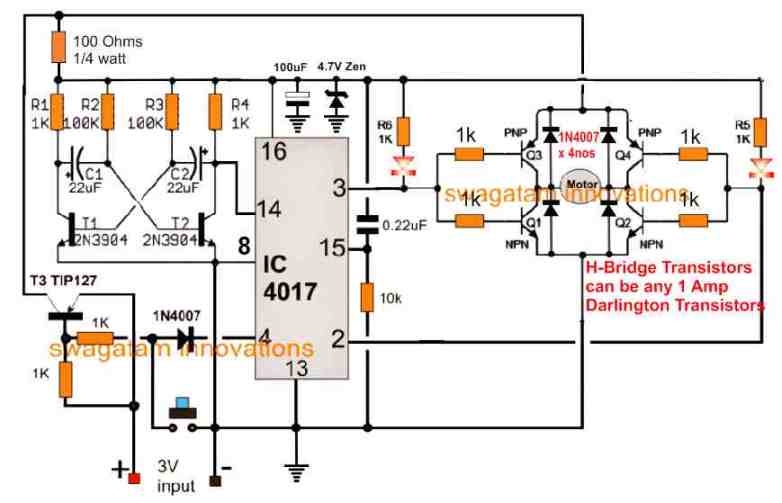In this post I have explained a simple programmed reverse forward motor circuit which is used for accomplishing a toy application. The idea was requested by Mr. Matthew.
Technical Specifications
I am a new follower of your website which is a great resource!
I need your help designing a circuit please.
My daughter has a project for school which is a motorized vehicle. I would like to be able to build a 2 stage timed circuit where a momentary switch would activate a forward motion for a few seconds.
Then reverse the polarity for a reverse action for a few seconds. The motor voltage would be 3v. It would be extremely helpful if you could assist this build. Thank you in advance.
Matty.
The Design
The proposed motor toy circuit which features an automatic forward reverse actuation using a sequential delay timer circuit can be visualized in the following diagram:
Referring to the above diagram, the T1, T2 stage along with the associated components form an astable multivibtator with an oscillator frequency period corresponding to the desired motor reverse forward timing period.
The TIP127 stage is the latch circuit for enabling a push button start for the circuit.
The IC 4017 executes the forward and the backward pulses for the transistor driver stage comprising of Q1-----Q4.

The transistor driver is configured as a H-bridge for facilitating the reverse forward motion of the motor in response to the triggers received from the IC 4017 outputs.
The circuit can be understood with the help of the following explanation:
When the push button is pressed momentarily, T3 receives a short ground pulse through the switch which initiates the transistor turning it ON and supplying a positive pulse to the circuit.
The initialization trigger causes a logic low to appear at pin4 of the IC 4017 which holds and latches T3 into a solid ON position even after the push button is released.
Simultaneously pin15 also receives a positive pulse resetting the IC such that pin3 begins with a logic high.
With pin3 initially high actuates the H-bridge and the motor in a particular direction depending upon the polarity of the motor wires across the bridge network.
Now T1 and T2 begin counting and the moment their set time lapses, pin14 receives a triggering pulse from the collector of T2 which forces pin3 high logic to shift to pin2.
The above condition instantly reverts the H-bridge polarity and causes the motor to initiate an opposite course of its motion, until the next pulse at pin14 of the IC arrives.
As soon as the subsequent pulse is sensed at pin14 of the IC 4017, the high logic at pin2 of the IC now moves a step ahead and settles at pin4 of the IC.
However since pin4 is associated with T3, a high at this pin immediately switches OFF T3, consequently breaking the latch and switching OFF the power to the entire circuit.
The toy motor circuit now entirely switches OFF until the push button is pressed again.
A 0.1uF capacitor should be connected in parallel with R2 so that each time power is switched ON T2 triggers ON first and enables a correct implementation of the system in terms of the set time intervals.
Video Proof
Adjusting the Time Delays
The time intervals can be set or adjusted as per user preference by altering the values of either R2/R3 or C1/C2 or both of these pairs.
Although the circuit is implemented as a toy here, it may have many interesting industrial applications and can be modified for executing several user specified programmed machine activations.
